Patmos: The Island We Love to Return to
Charming architecture, unique beaches, rich history,...
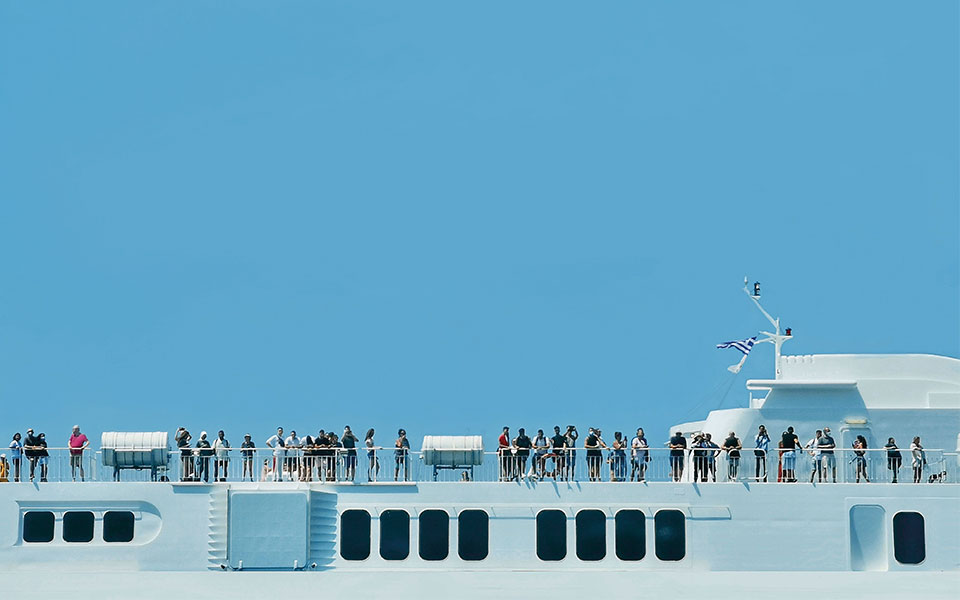
© @ledart

Amorgos
© @inspirationsgr
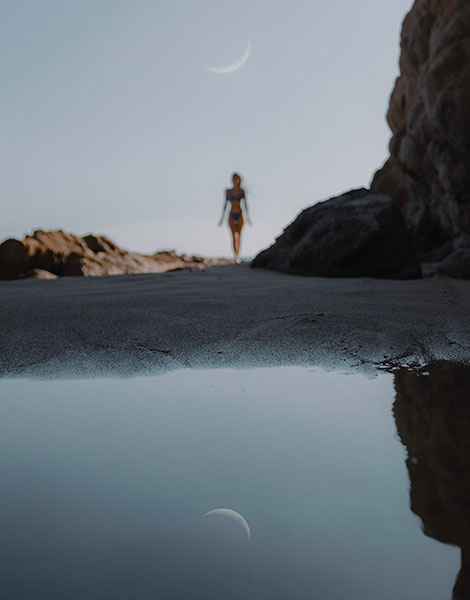
Anafi
© @souhoho
It’s not just the hit 1988 film “Le Grand Bleu,” shot in part on the island, that drew tourists here; it’s also its beautiful countryside, with impressive canyons, winding roads and quaint villages. Amid towering rocks, the white Monastery of Panaghia stands out like a sparkling gem. Below it lies the picturesque harbor of Aghia Anna, a wonderful place to swim. Head to the southern tip of the island for another great swimming spot, at beautiful Kalotaritissa Beach. On the way to the village of Aegiali, you’ll enjoy views of the exotic beach of Aghios Pavlos, a narrow strip of land flanked by turquoise waters. The landscape on the way to the beaches of Mouros and Ammoudi is different still. Put on a pair of comfortable shoes, take some water with you and hike the path from Tholaria that leads, after an hour or so, to the narrow bay of Mikri Vlychada. After your swim, head back to Tholaria to enjoy one of the most tranquil sunsets in the Cyclades from a table at one of the village’s eateries. -Nena Dimitriou
Ferry or high-speed ferry from Piraeus (5.5-9 hours). Flight to Naxos or Milos, then ferry (1.5 and 3.5 hours, respectively), or via local boat from Naxos (4 hours).
Lost in time itself, Anafi will teach you what it’s like to forget about the clock and the calendar. Try the goat meat, cooked by Agapi, at the Astrachan taverna, dance on the tables at the Armenaki restaurant, swim at Roukounas, Aghii Anargyri or Livoskopos beaches, have drinks at Mylos bar in a traditional windmill, flirt until the morning hours at Madres bar and don’t leave the island without climbing up to Kalamos to enjoy the sunset or the sunrise from the second highest monolith in Europe. -Vlassis Kostouros
Ferry from Piraeus (11 hours). Flight or high-speed ferry to Santorini, then ferry (1 hour).
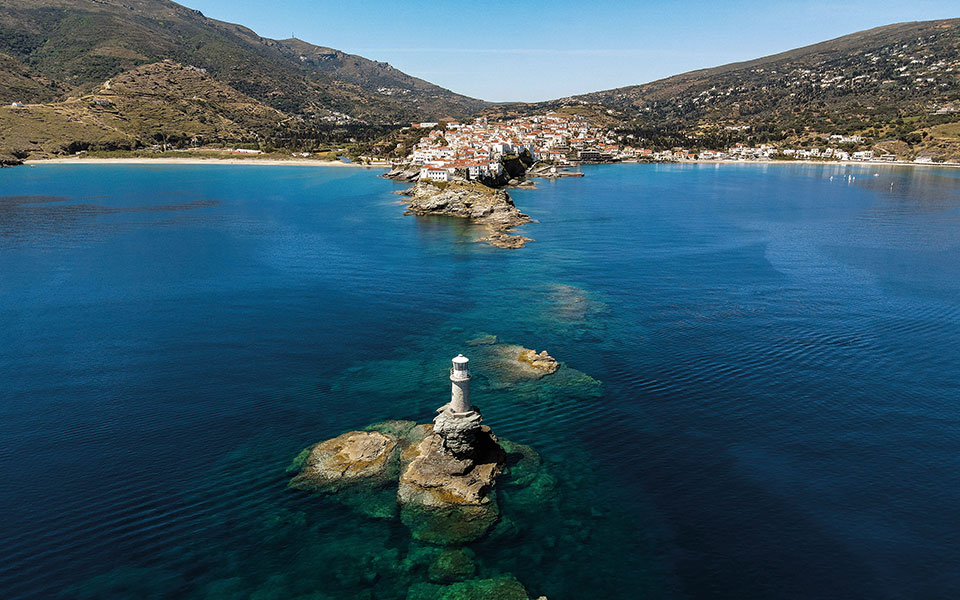
Andros
© @andros_secrets, @n_kaldelis
Endowed with fresh water – a rare blessing for the Cyclades – Andros is an island that’s rich in natural beauty and in the unexpected joys it offers to its visitors. All you need is a car and the willingness to drive long distances; even in the middle of summer, you’ll be able to escape the crowds on some of the most spectacular secluded beaches in the South Aegean. Thanks to its size, the island doesn’t get as crowded as its neighbors. In addition to the noble Hora, be sure to visit some of the other villages, such as Korthi, Stenies, Syneti and Paleopoli; they’re all charming and humble. -Georgios Lialios
Ferry or high-speed ferry from Rafina (2-4 hours).

Antiparos
© @alexiou_christina
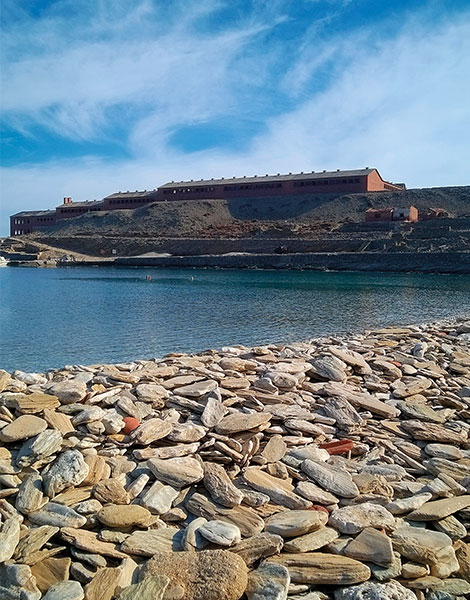
Gyaros
© @nek_tar_ios/Nektarios Farassopoulo
The bohemian feel and the cosmopolitan atmosphere on Antiparos have a refreshing effect; stress evaporates from the first minute one steps onto the paved whitewashed alleys of the island, popular even with Hollywood stars. The sunsets are spectacular; the most impressive can be enjoyed from Sifneiko Beach. The deep blue sea is inviting, and the richness of the seabed is generously revealed with each dive. A one-day kitesurfing adventure is an ideal option for those looking for excitement. As for the best sunrise, that would be the one you enjoy after a whole night out at the disco La Luna. -Elina Dimitriadi
Ferry, high-speed ferry (3-5 hours), or airplane to Paros, then ferry from Pounta (10 mins).
This is an island that was used as a prison for political dissidents, first during the early Roman empire and then again in the 20th century. Today, Gyaros is at the heart of a protected area. Its remote location means that it’s a paradise for marine life, hosting dozens of rare fish and bird species, as well as the endangered Mediterranean monk seal, Monachus monachus. As a nature reserve, Gyaros is strictly off-limits to the public. Permission to approach the island can only be granted for research purposes by the port authority of Syros. -Georgios Lialios
Even with prior permission, private vessels are only allowed to dock in certain bays.

Delos
© @travelscrapbookgr/Eirini Fengoudaki
The trip from Mykonos takes just 30 minutes, and yet you’ll be traveling back almost 20 centuries, crossing from a lively international tourist destination to what is, in essence, an outdoor museum. It was on Delos where, according to myth, the twin gods Apollo and Artemis were born. A prime pilgrimage site during antiquity, it was thought so sacred that nobody was allowed to be born or to die on the island; the ill were rushed off, and pregnant women approaching their due dates were sent away. Today, a tour of this UNESCO World Heritage Site is an unforgettable experience. There’s little shade on the island, so be sure to bring a hat and plenty of water. -Eleftheria Alavanou
Local boat from Mykonos (30 mins).
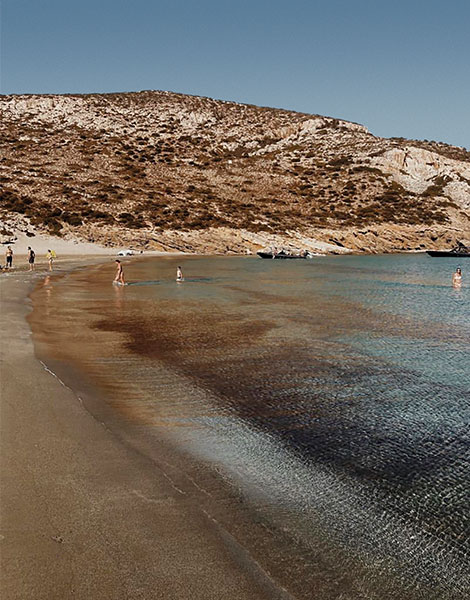
Despotiko
© @alexiou_christina
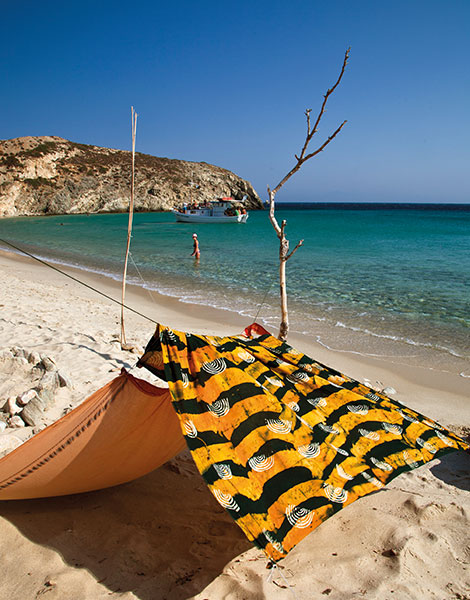
Donoussa
© @olgacharami
Tiny Despotiko hasn’t had a lucky past. Recent archeological finds show that Paros, trying to rival the mighty rule of the Athenians and their “sacred” island of Delos, built a large temple to Apollo there, only to see it destroyed by the all-powerful city state of Athena. And then there’s the medieval account of the French pirates who slaughtered the entire native population, wreaking vengeance on the locals for surrendering a fellow Frenchman, the pirate Daniel, to the Ottomans. Despotiko has remained uninhabited ever since. Today, you can go enjoy its pristine sandy beaches by hopping on a small boat on nearby Antiparos. -Dimitris Karaiskos
Private vessel or tourist boat from Antiparos.
As the name pointing to the Greek word for vibrate suggests, Donoussa has its own special pulse. Chilling out on Kedros beach, and gravitating between the water and the bar, is actually an inner journey between the “can” and the “want.” If Donoussa loves you, it will bring out your better self, rooting it out from the layers of discipline built up over the winter months. Every day starts at Stavros, the main village, with the sound of church bells and the aroma of freshly baked bread. At Livadi, there’s always some youngster to help you off the boat “Donoussa Magissa.” At its few but well-kept tavernas – in Avali, Ambelaki or at Kalotaritissa – the tomatoes smell like they’ve just been plucked from the vine. -Amanda Michalopoulou
Ferry from Piraeus (7 hours), high-speed ferry, or flight to Naxos, then local ferry (4 hours).
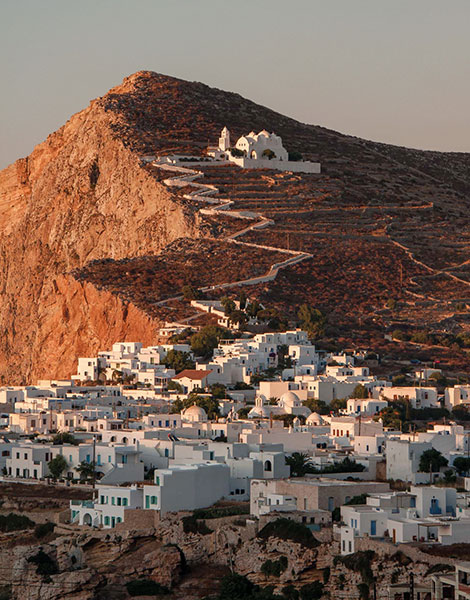
Folegandros
© Nikos Karanikolas
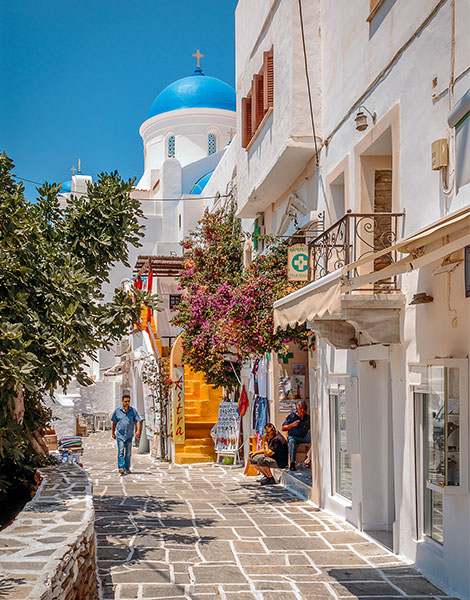
Ios
© Sime/Visualhellas.gr
Folegandros’ capital village, known as Hora, in the Cyclades, will amaze you with its narrow cobblestone streets, bursts of purple bougainvillea, and whitewashed houses with blue windows and doors. It’s picture-perfect and yet it’s real, with permanent residents. The medieval part of Hora, with its centuries-old structures, is the most atmospheric spot on the island, but Ano Meria, where the themonia – homes organized as small, self-sustaining agricultural and animal-breeding units – was born, has its own charm. The Aspropounta Lighthouse is a hidden jewel, nestled on the edge of a slope covered in wild herbs and flowers. -Eleftheria Alavanou
High-speed ferry from Piraeus via Milos (4.5 hours). Ferry from Piraeus or Lavrio (9-13 hours).
In the seventires, Ios was discovered by the hippies; in the ’90s, the barflies took over. Today, its crowd is rather mixed and contains everything from high schoolers taking their first vacations without their parents to fine-dining aficionados. The island’s trademarks are endless beaches with honey-colored sand (Mylopotas, Manganari, Koubara, Aghia Theodoti and Psathi), its hundreds of white chapels, and the bars and restaurants in Hora. Its greatest – although relatively unknown – treasure is the archaeological site of Skarkos, near Hora, a well-preserved early Cycladic settlement that reached its peak around 2,700-2,400/2,300 BC. -Eleftheria Alavanou
Ferry or high-speed ferry from Piraeus or Rafina (4-10 hours). Flight to Santorini, then high-speed ferry (40 mins).
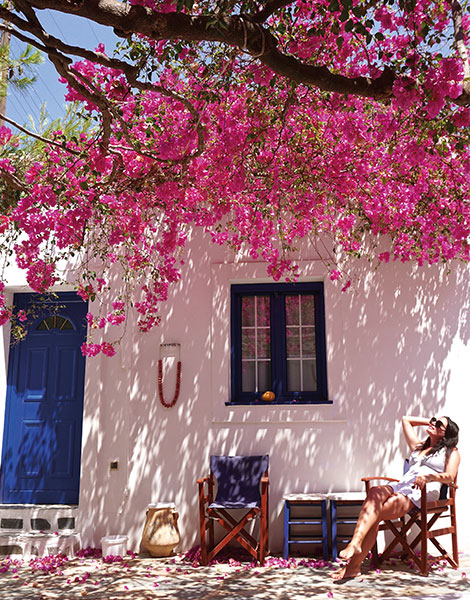
Iraklia
© @des_tina_tion/Konstantina Papaioannou

Kea
© @perikles_merakos
You’re on a boat trip, and out of the blue, the locals invite you to an impromptu seafood feast right on the beach. The food is cooked on the spot, on an improvised grill made of stones and reeds. Everything happens effortlessly. And if your host is Martin, as mine was, he’ll probably offer to take you to Hora, the capital village, to get a cheese pie or to the port for supplies. Everyone here is friendly; in Iraklia, you’ll never get lonely. This island invites you to share your towel, your table and your time. -Amanda Michalopoulou
Ferry from Piraeus (7 hours). High-speed ferry or flight to Naxos, then local boat (1.5 hours).
Even though its proximity to Lavrio port has made it a popular and easy getaway for Athenians, Kea is more than a weekend island. Because no matter how long you spend on it, it will reward you equally and more. You can explore the pretty, snaking streets of hillside Ioulida, the island’s capital, looking for the famous 6th-century BC stone lion with the cheeky smirk. You can go on an extended beach safari, like a modern-day Robinson Crusoe, taking the trails less traveled to dreamy and isolated strands like Sykamia and Spathi. Mostly, though, Kea invites you to walk, heading out when the sun is not so harsh. Whichever of its 81-kilometers’ worth of paths you pick, don’t miss the one to ancient Carthaea for a cleaning swim just below the ruins. -Alexandra Mandrakou
Ferry from Lavrio (1 hour).
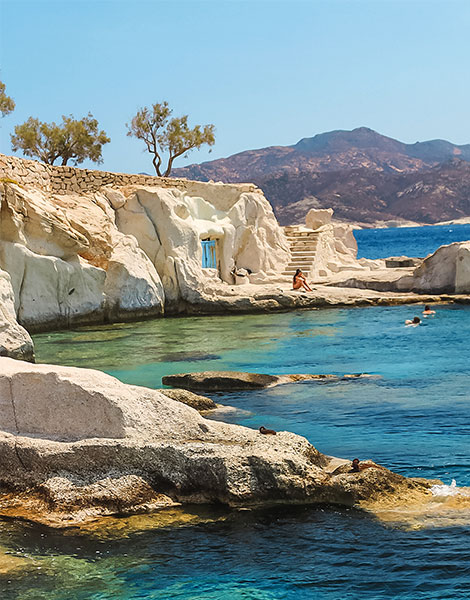
Kimolos
© @takisdamvakaris
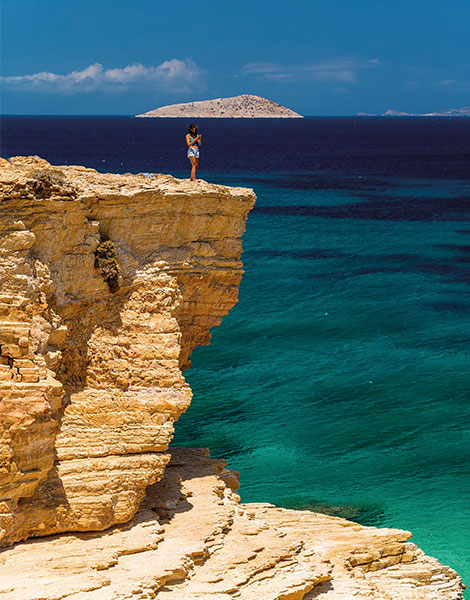
Koufonisi
© @spirossorips/Spiros Sklavenitis
Pure, authentic, peaceful, full of surprises and great food, Kimolos is a refuge and a seaside garden of earthly pleasures. You must try the local cheeses and the ladenia, the island’s simple but wonderful version of the pizza, hot and fresh from the traditional bakeries of the village. At Prassa Beach, the sand is white, the sea is turquoise, and there’s a bar, too. At Goupa, there is an elephant-shaped rock that will offer you its soothing shade, while at Mavrospilia the sunset has a mystical charm. -Elina Dimitriadi
Ferry from Piraeus (7-10 hours). Flight or high-speed ferry to Milos, then ferry crossing (20 mins).
A dive into the waters of Italida Beach at Ano Koufonisi feels like a baptism of sorts. From the shore here, you can see Keros, a small island that was of great importance to the early residents of the Cyclades and to the ancient Greek world as a whole. Koufonisi has changed a lot since the days when the guests of the very first hotel, Finikas, had to ride on tractors up from the port but mornings on this stretch of sand still feel like nothing’s changed. Despite growing numbers of tourists, hotels and cars, this island retains at its core all the magic that you felt the first time that you came. -Amanda Michalopoulou
Ferry or high-speed ferry from Piraeus (5-8 hours).

Kythnos
© @petros_kamin
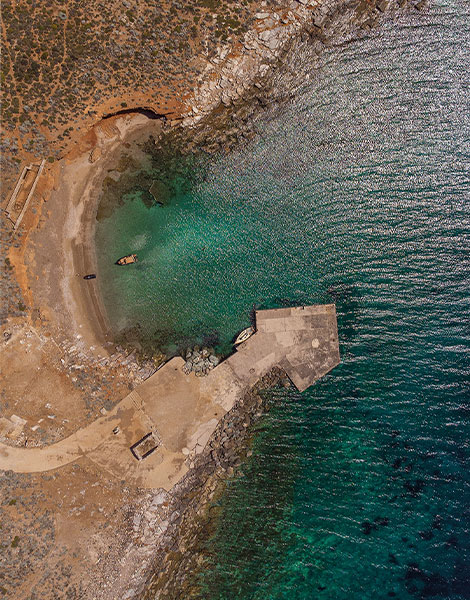
Makronisos
© @panagiotis_trafalis
Kythnos is located just two hours from Athens; even so, up to a decade ago, it was unknown to most Athenians. A Cycladic island that doesn’t look like one – it has more greenery, and a low-key main village that shares the attention of visitors equally with Merichas, the port. The most atmospheric settlement is Dryopida, with its tiled houses and Katafiki Cave, and the most impressive beach is Kolona, where a sandbar divides the sea in two. Hiking to Oria Castle, where wild capers grow in cracks in the rocks, is a good way to spend a late afternoon before an evening filled with traditional violin music and local dances. -Eleftheria Alavanou
Boat from Lavrio or Piraeus (2-3 hours).
Makronisos (Greek for “Long Island”) is an uninhabited rocky islet with a sad history: between 1947 and 1958, in the aftermath of the Greek Civil War, it was used as a military prison. Today, the remains of the prison camp lend an eerie atmosphere to the whole island, which has been declared a monument. The island is accessible, by charter only, from the nearby port of Lavrio; despite its tragic past, it’s a tranquil spot with beautiful waters. -Dimitris Karaiskos
No routes in operation. Access only via private boat.
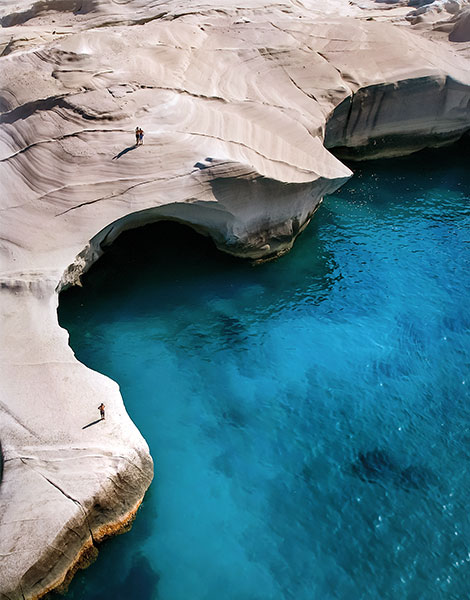
Milos
© @chris_kap.2
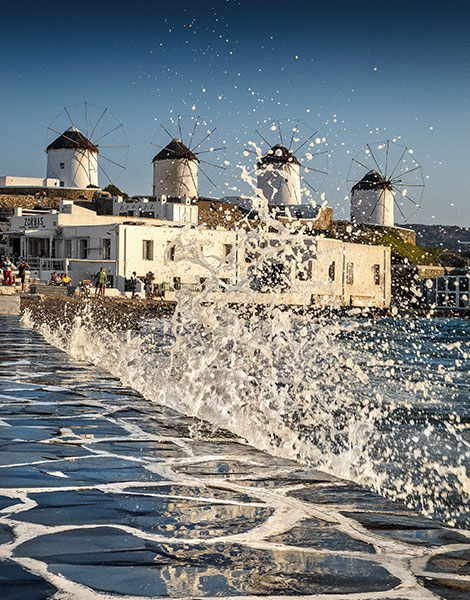
Mykonos
© Giannis Giannelos
Beaches of amazing natural beauty have put Milos at the top of the most popular Greek destinations list, but it’s not just the shores that are charming. Any time left over from your marine explorations should be spent wandering the narrow cobbled streets of Plaka, visiting the Archaeological Museum, or stopping somewhere with a view over the bay for food and drink. Downhill from Plaka lie the settlement of Trypiti, the Ancient Theater and the Catacombs. Not far is Klima, the most famous fishing village, with characteristic bright-colored structures that used to house the fishing boats during winter. Today, they’re available as perhaps the loveliest accommodation spaces in the Aegean – the crystal-clear waters are literally six steps from your bed. -Natasha Blatsiou
Ferry or high-speed ferry from Piraeus (3.5-8 hours). Direct flight from Athens.
On the one hand, there are Michelin-awarded restaurants, cosmopolitan crowds at Psarou Beach, celebrated art galleries, high-fashion boutiques, five-star accommodations and wild parties at bars on Matogianni Street and on beaches such as Super Paradise and Agrari. On the other, there’s picturesque Ano Mera with its wonderful tavernas, chapels of rare architecture and the secluded beauty of the sandy beaches of Aghios Sostis, Fokos and Kapari. The breezes on the “island of the winds” will fill your sails and guide you to whatever form of luxury you prefer. -Vlassis Kostouros
Ferry or high-speed ferry from Piraeus (2.5-5 hours). Direct flight from Athens.
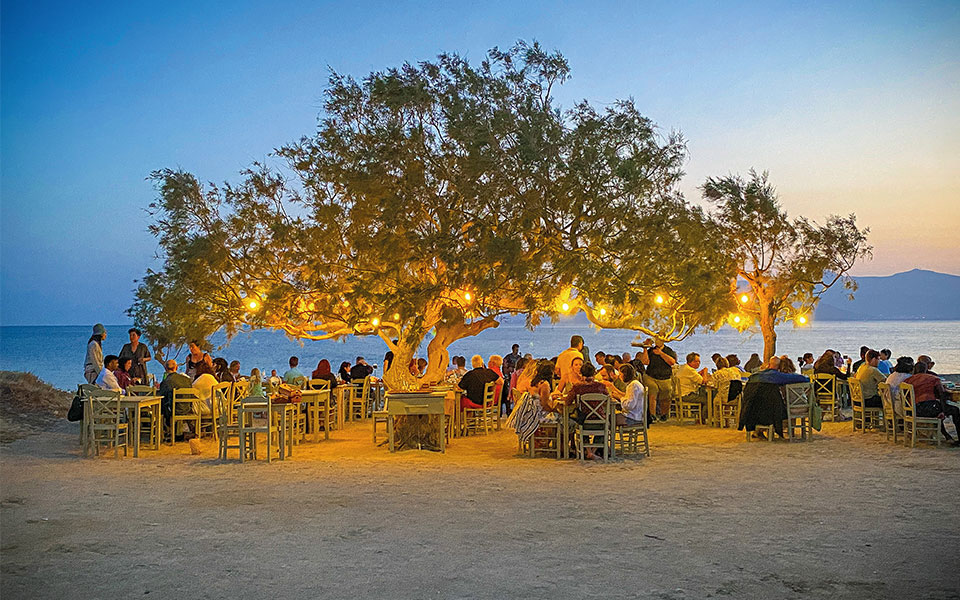
Naxos
© @steve_gormley
A Large island with a lot to see, this destination needs more than one trip to do it justice. A wonderful combination of natural beauty and history makes it particularly compelling. Portara, the great gate of the unfinished Temple of Apollo dominates the port of Naxos Town and is the island’s trademark. Naxos has golden beaches for every taste and unspoiled mountainous villages, each different from the other, where the traditions of the island have survived intact. Once the center of the early Cycladic culture, today it’s known for its rich agricultural production – with many PDO products, such as potatoes and arseniko cheese – which local chefs put to great use in wonderful dishes. -John Papadimitriou
Ferry or high-speed ferry from Piraeus (3.5-6 hours). Direct flight from Athens.
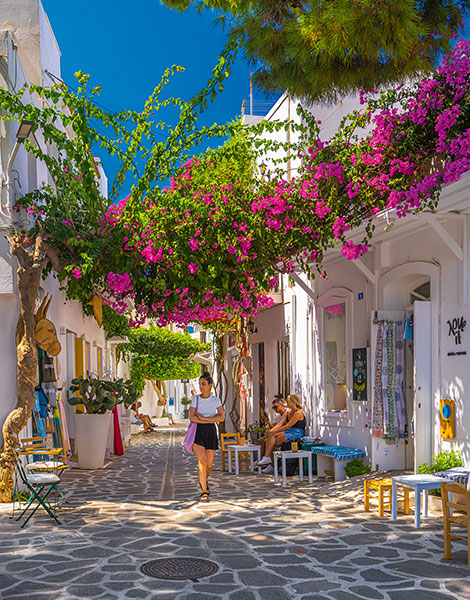
Paros
© Sime/Visualhellas.gr
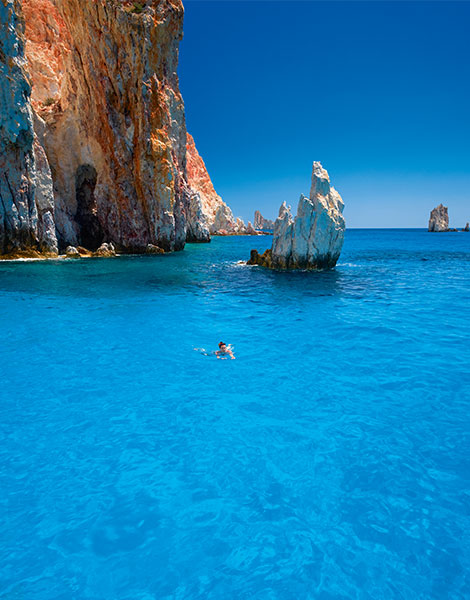
Poliegos
© @perikles_merakos
With a new airport and frequent ferry connections, Paros is first on the list of easily accessible islands. Tourist development has reached even its lesser-known villages. The French community on the island is growing, and Paros is also attracting a number of digital nomads, since it has everything – beaches, good food and accommodations for every taste and budget. The village of Naousa remains the heart of the island’s nightlife. In its restaurants, you’ll find several local wines from the island’s six wineries, as well as international options. The island is a little like those wine selections; local and cosmopolitan, and always intoxicating. -John Papadimitriou
Ferry or high-speed ferry from Piraeus (3-5 hours). Direct flight from Athens.
Poliegos is a miraculously pristine island that welcomes all visitors who respect its fragile beauty. The sole inhabitants of this island, which is located between Kimolos and Milos, are its goats and their shepherd, who stand proudly on the volcanic hills and the rocks that have been carved by time and the crystal clear sea into marvelous formations, and its squawking seabirds. Access is possible only by private yacht. If you’re lucky, you might get to watch an unforgettable nighttime outdoor screening here, put on by the outdoor cinema from nearby Kimolos. -Elina Dimitriadi
Private vessel or tourist boat from Milos or Kimolos.
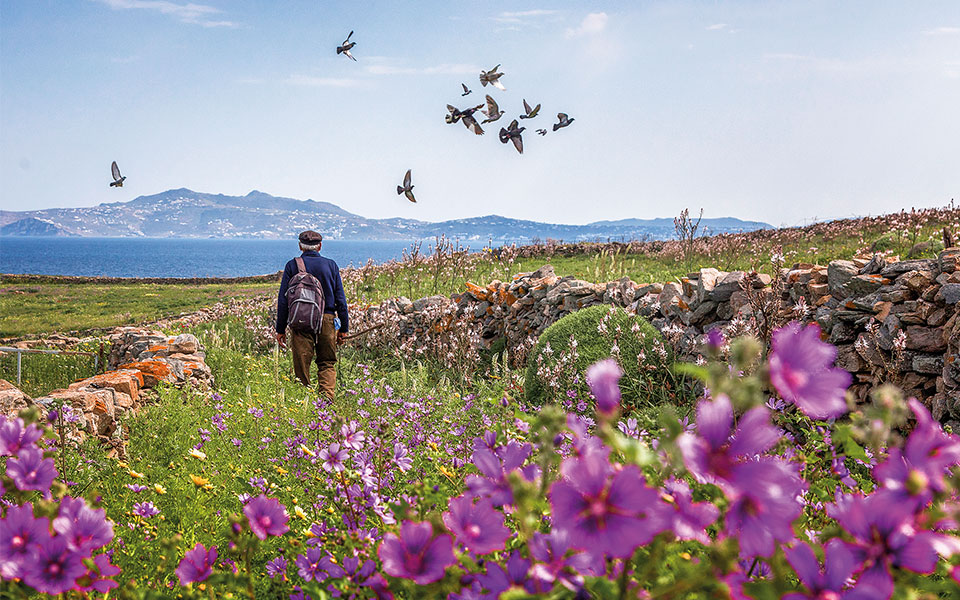
Rinia
© @perikles_merakos
Some of the most iconic images of Cycladic beaches and emerald waters untouched by tourism acome from photographs taken on uninhabited Rinia, close to Delos. Anyone visiting on a private boat or on an organized excursion from neighboring Mykonos or Tinos will be enchanted by the unspoiled beauty of Rinia, its white beaches, its clear waters and the scent of dry grass and soil. An island that’s also an archaeological site, the findings from which are displayed in museums in Greece and abroad, Rinia was first settled in the 5th millennium BC. Essentially a satellite of its neighbor, Rinia was where the inhabitants of ancient Delos came to give birth or to die, as neither was permitted on their sacred island. -Maya Tsoclis
Private vessel or tourist boat from Mykonos.

Santorini
© Alberto Lora/Unsplash
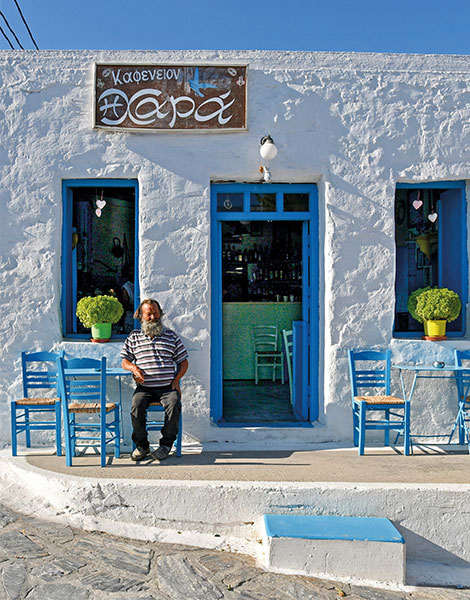
Schinoussa
© @katerinakatopis/Katerina Katopis-Lykiardopulo
Even the swarms of tourists can’t undo the gloriously otherworldly feeling Santorini gives you. Its settlements, perched on the edge of hundred-meter-tall sheer volcanic cliffs rising straight from the sea, are places of unique, breathtaking beauty. In the village of Oia, you can enjoy spectacular sunsets and descend 214 steps to the old port to get a sense of the island’s glorious nautical past and enjoy fresh fish at the local tavernas. The lunar landscape of Vlychada Beach is unforgettable, as is a visit to the old lighthouse at Akrotiri and the awe-inspiring prehistoric town, preserved for archaeologists and tourists by the volcanic ash that covered it millennia ago. In such a setting, you could be forgiven for thinking, as you stare south in the direction of Crete, that, just beyond the horizon, King Minos and the Minotaur might yet be alive. –Dimitris Karaiskos
Ferry or high-speed ferry from Piraeus (5-12 hours). Direct flight from Athens.
A famous stop on the Aegean sailing scene, this island is becoming well known for its fava dish, made from katsouni, a rare pea legume. Sun-drenched Schinoussa has two settlements – Hora and Messaria – sparse vegetation and exceptional beaches. While tourist development has increased of late, other sources of income have not been completely abandoned – there are still locals involved in farming and raising livestock. The road network is not very good, so it’s best to opt for a car instead of a motorbike or bicycle. -Eleftheria Alavanou
Ferry from Piraeus (7 hours). Flight to Naxos, then local boat (2 hours).
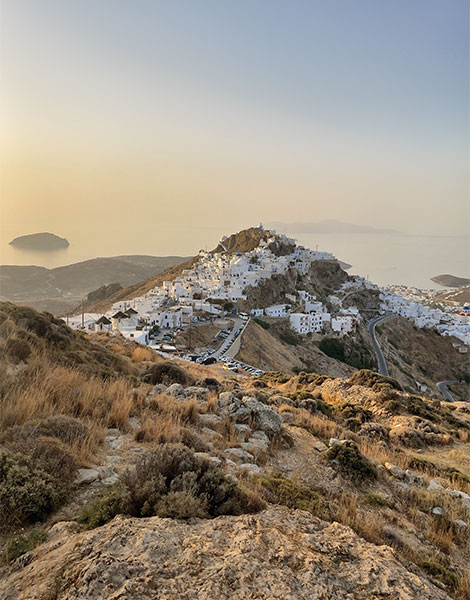
Serifos
© Despina Galani/Unsplash
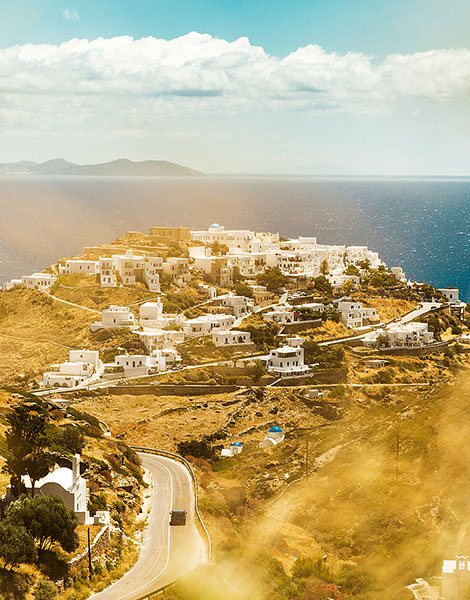
Sifnos
© @dimvlaikos
looking down on the best beach on Serifos, Kalo Ampeli, is like gazing at a picture-perfect postcard – everything is intensely vibrant. The main village, Hora, is a steep climb up from the sea. Walk around the old fortified part and enjoy evening drinks in the alleyways around the town hall. Hora’s gleaming white houses are clearly visible from the harbor of Livadi, where the ferries dock. The calm turquoise waters you find off the beaches of Ganema, Vagia and Aghios Sostis are quite relaxing; there are eateries at the first two of these. -Elina Dimitriadi
Ferry or high-speed ferry from Piraeus (3-5 hours).
This island has all the ingredients that make up a Cycladic paradise: beaches with crystal-clear waters, blue-domed chapels and white-washed local architecture, picture-perfect settlements and a local gastronomic tradition that is arguably one of the finest in Greece (the many top-notch restaurants on the island testify to that). Be sure to visit the Kastro – a fortified settlement dating from the medieval period, built over the ruins of an ancient acropolis. There, views out over the Aegean are breathtaking – as are the orange skies at sunset as seen from the island’s port, Kamares. -Dimitris Karaiskos
Ferry or high-speed ferry from Piraeus (5-12 hours).
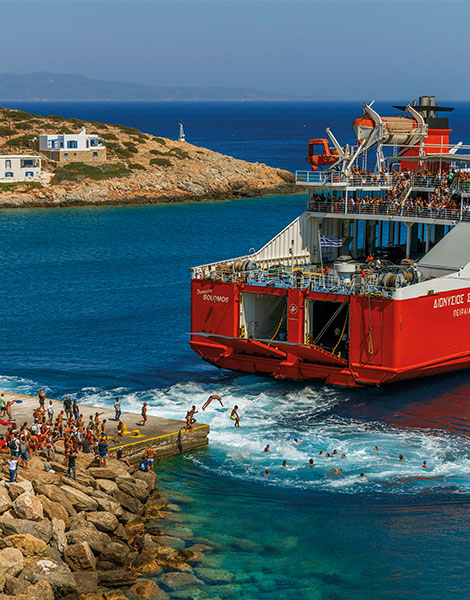
Sikinos
© @apos_apos/Apostolos Apostolopoulos

Syros
© @travelscrapbookgr/Eirini Fengoudaki
Hora, a gorgeous village suffused in light that serves as the island’s capital, will astound you. Geraniums decorate the doorways of pristine white houses built in the traditional Cycladic style, and there’s a wonderful energy here, too, as there is on the whole island. Since most of Sikinos’ beaches are accessible only on foot or by boat, Hora is the place where everyone gathers, although this doesn’t mean it’s crowded. Follow the cobbled streets up to lovely Chrysopigi Monastery at the top of the settlement to enjoy some wonderful views. Another charming site on the island is Episkopi, a disused monastery that was housed in a repurposed Roman mausoleum. A stop at Manalis Winery on your return from the monastery is recommended. You can enjoy a glass of Monemvasia, Assyrtiko or Aidani wine while taking in tremendous views of the Aegean. –Olga Charami
Ferry from Piraeus (10 hours). Flight to Santorini, then high-speed ferry (2 hours).
Ermoupoli, which seems to rise up from the horizon as your ferry approaches, enchants even before you reach its harbor. Its steep twin hills, elegant neoclassical architecture and air of faded grandeur make for a jewel of a town. Its present is as intriguing as its past: over recent years, countless creative spirits came here from all over to start afresh, adding much to an already active cultural scene. Festivals run through the summer, art galleries flourish and a unique café culture has taken root. Don’t miss Asteria, a row of jetties below the Vaporia neighborhood: a city swim with Ermoupoli’s Italianate houses as a backdrop is a quintessential Syros experience. -Alexandros Massavetas
Ferry or high-speed ferry from Piraeus (2-4 hours). Direct flight from Athens.
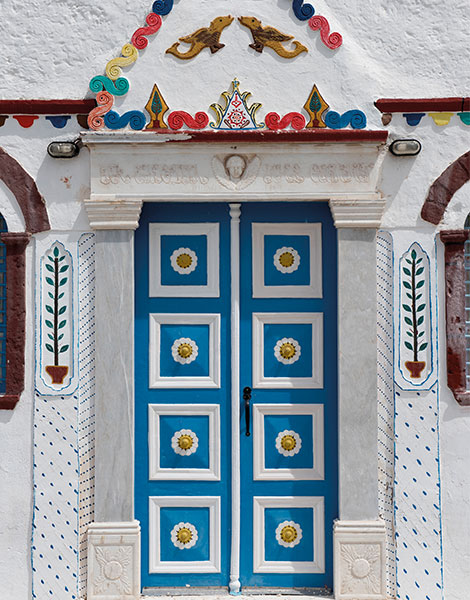
Thirasia
© @vkzavosphoto

Tinos
© @travelscrapbookgr/Eirini Fengoudaki
A small paradise, unknown to most people, this island is only a stone’s throw from Santorini. As soon as you leave the small port of Riva, you’re in another Greece, one from a faded photo, rural and forgotten, and also extremely charming. Most houses in Manolas, the main settlement of the island, have courtyards full of flowers, and from here there are wonderful views out across the caldera. (Once, before the massive volcanic eruption in prehistoric times, Santorini and Thirasia were part of a single island.) In the deserted settlement of Agrilia, the Church of the Presentation of the Virgin still stands, its colorful decorations carefully maintained. On the island, hiking trails carved into volcanic rocks lead to old churches and monasteries, replanted vineyards and rugged capes. Down at the settlement of Korfos, the island’s old harbor, you can have lunch barefoot at one of its beachfront tavernas. -Maya Tsoclis
Catamaran from Santorini (15 mins).
The best-preserved hinterland of the Cyclades has more than 45 traditional villages, including Pyrgos, Kardiani, Volax and Triantaros, whose inhabitants have retained the folk architecture of their houses and many old customs. Paths cover most of the island, and farmhouses and dovecotes adorn a unique terraced landscape shaped largely by human hands. An island that spent five centuries under Venetian rule, it’s famous for its cultural events and its museums, but it’s also an island that produces, among other things, wines and beers that have in recent years won many international awards. The Greeks themselves are most familiar with Tinos as a pilgrimage site where supplicants seek the help of the Virgin Mary, and this fact may have been instrumental in saving the island from the rampant tourist development that other Cycladic islands have suffered. However it happened, Tinos has managed to maintain a reputation for authenticity, something many people seek in a destination. -Maya Tsoclis
Ferry from Piraeus (3.5-4.5 hours). High-speed ferry from Rafina (1 hour 50 mins).
Charming architecture, unique beaches, rich history,...
The signature dish of the island...
From Samos to Crete, we've selected...
Unspoiled beaches, authentic flavors, and a...